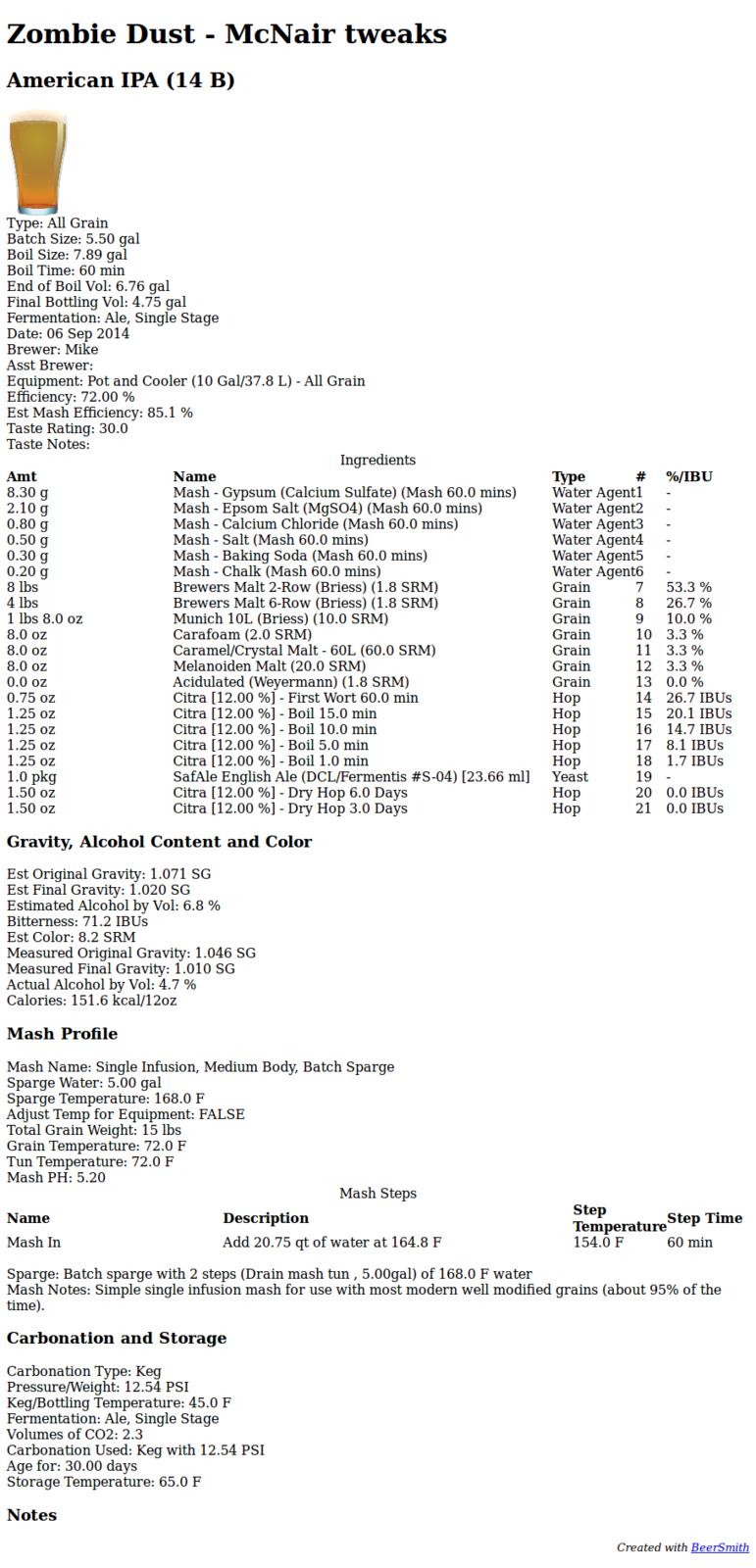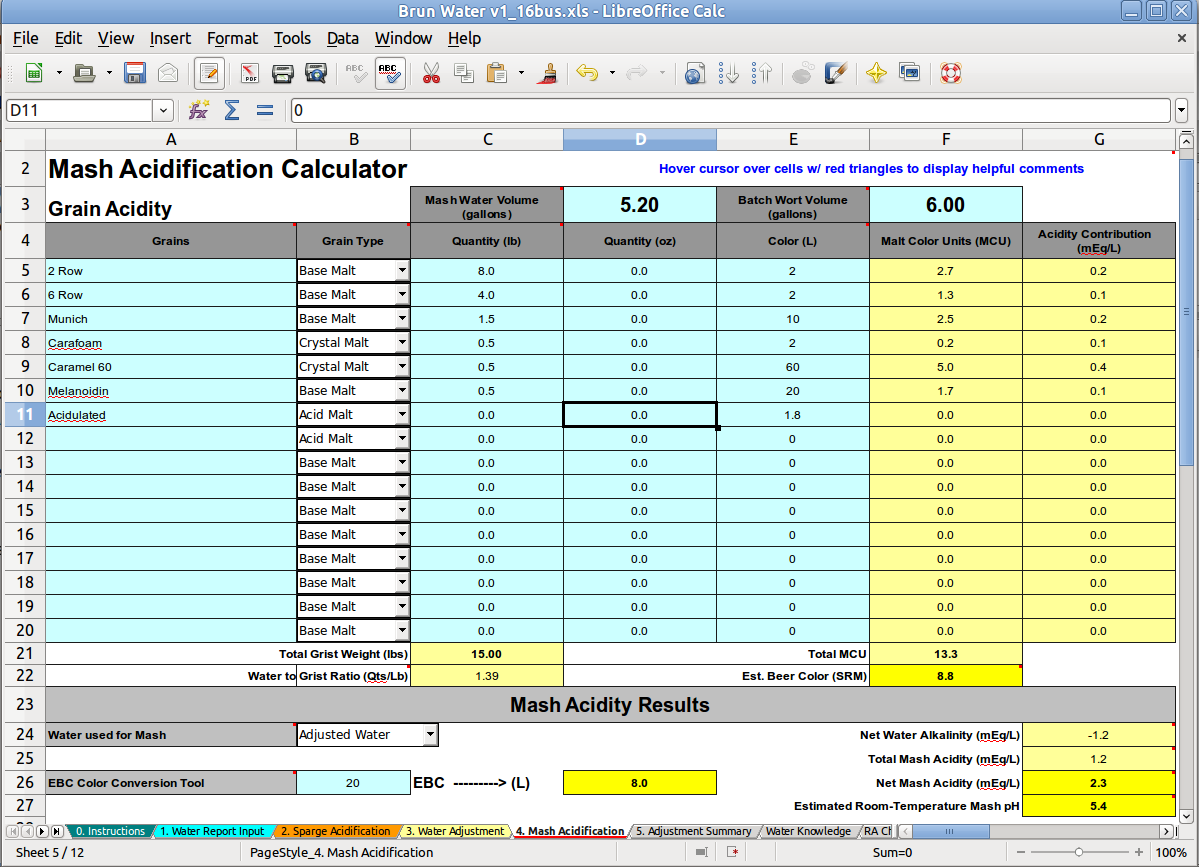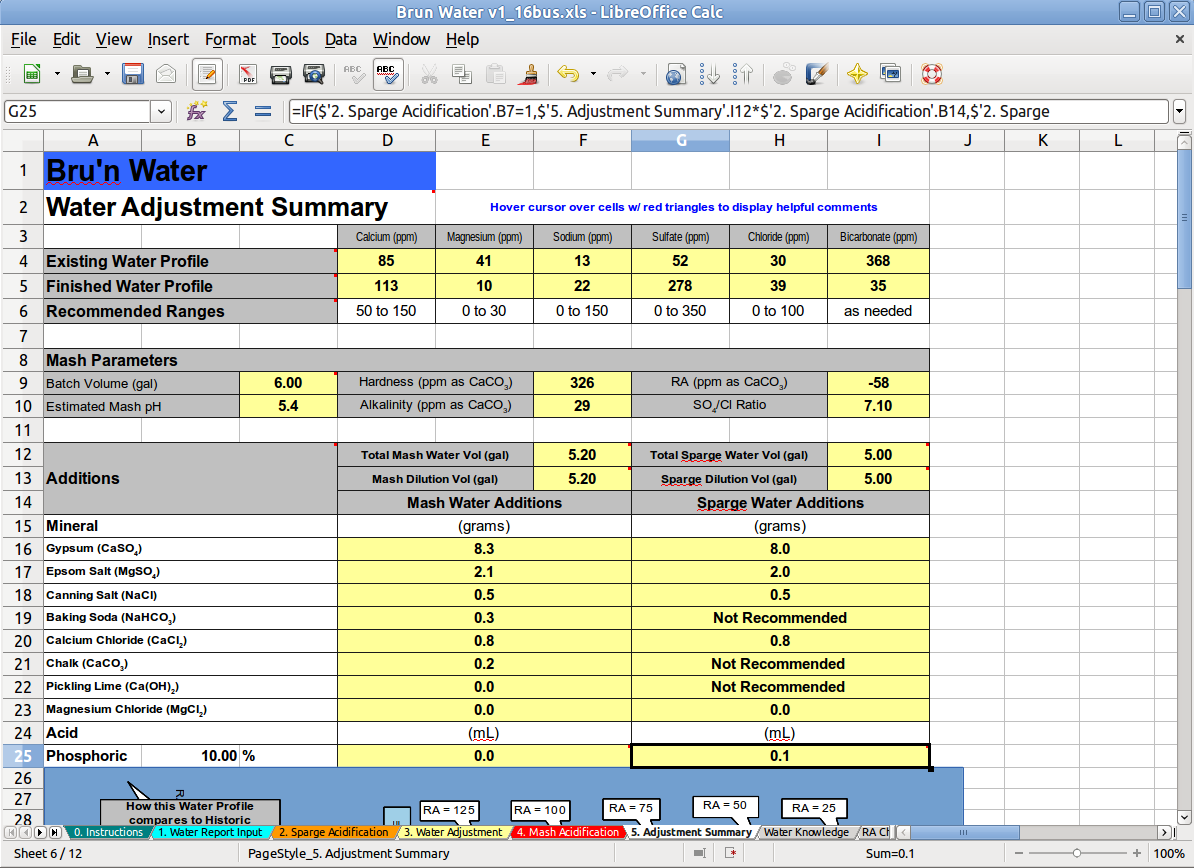It occured to me this morning that a simpler explanation for the buffer is that a buffer is a mixture of an acid and a base and if water is removed both are concentrated by the same amount so that their concentration ratio stays the same.
You are using an out of date browser. It may not display this or other websites correctly.
You should upgrade or use an alternative browser.
You should upgrade or use an alternative browser.
Mash pH
- Thread starter PlinyTheMiddleAged
- Start date

Help Support Homebrew Talk - Beer, Wine, Mead, & Cider Brewing Discussion Forum:
This site may earn a commission from merchant affiliate
links, including eBay, Amazon, and others.
I brewed a Belgian Pale Ale this weekend. Here are the results:
Using RO water with 6.8 grams of calcium chloride and 4.7 grams gypsum for a 10.5 gallon batch (Amber Malty target in Bru'n) and simple grain bill:
1. Mash pH settled at 5.35, and dropped slightly into the boil kettle to 5.32. I acidified the sparge to 6.0 to be safe.
2. Boil pH dropped to 5.14 into the fermenter, with hot break formation about 10 minutes into the boil. Boil was very strong - I usually boil off about 1.2-1.3 gallons/hour.
That is a 0.18 drop in pH units in the boil kettle - on the fringe of the 0.1-0.2 range expected. This was a malt forward batch with relatively little hardness, and calcium at about 58 ppm. I had planned to check on 5 minute intervals, but was interrupted and mixed the samples so abandoned that. Will try this on a future IPA or APA brew.
I am wondering if larger swings are potential using RO water rather than treated tap water where most or all of the alkalinity has been removed. Could this leave more calcium (depending on water target profile) to react with phosphates, etc. from the mash and into the boil, skewing the expected pH to drop lower?
Using RO water with 6.8 grams of calcium chloride and 4.7 grams gypsum for a 10.5 gallon batch (Amber Malty target in Bru'n) and simple grain bill:
1. Mash pH settled at 5.35, and dropped slightly into the boil kettle to 5.32. I acidified the sparge to 6.0 to be safe.
2. Boil pH dropped to 5.14 into the fermenter, with hot break formation about 10 minutes into the boil. Boil was very strong - I usually boil off about 1.2-1.3 gallons/hour.
That is a 0.18 drop in pH units in the boil kettle - on the fringe of the 0.1-0.2 range expected. This was a malt forward batch with relatively little hardness, and calcium at about 58 ppm. I had planned to check on 5 minute intervals, but was interrupted and mixed the samples so abandoned that. Will try this on a future IPA or APA brew.
I am wondering if larger swings are potential using RO water rather than treated tap water where most or all of the alkalinity has been removed. Could this leave more calcium (depending on water target profile) to react with phosphates, etc. from the mash and into the boil, skewing the expected pH to drop lower?
I would say no. Acid treatment of tap water should leave Ca levels unchanged so I think the kettle drop should be similar to RO. Lime treatment would precipitate Ca, so that's another ball of wax...
Boy am I a pH geek since I really the values you used for that brew but I have no idea of the ingredients...
Boy am I a pH geek since I really the values you used for that brew but I have no idea of the ingredients...
PlinyTheMiddleAged
Well-Known Member
- Joined
- Jan 9, 2014
- Messages
- 377
- Reaction score
- 106
Well, last night I brewed two 1 gallon batches of beer - both used identical water recipes (distilled with added salts). I was targeting 5.4 and 5.2 for each of the mashes. I used acidulated malt to drop the pH (replaced some 2 Row with acidulated malt). I scaled down the Zombie Dust recipe found on the recipe database here (and adjusted slightly to reasonable weights).
Both worts were identical in terms of pre-boil sg and post-boil og. However, I did miss my targeted pH values slightly - 5.45 and 5.29. I'll report back when the batches are fermented and bottled.
I will say that I hope to have my hop forward beers figured out soon. Brewing one gallon diagnostic batches of beer is a heck of a lot of work for such a yield. I look forward to brewing decent IPAs and going back to 5 gallon batches.
Both worts were identical in terms of pre-boil sg and post-boil og. However, I did miss my targeted pH values slightly - 5.45 and 5.29. I'll report back when the batches are fermented and bottled.
I will say that I hope to have my hop forward beers figured out soon. Brewing one gallon diagnostic batches of beer is a heck of a lot of work for such a yield. I look forward to brewing decent IPAs and going back to 5 gallon batches.
Cheers and kudos for doing the experimental batches 
That said, my gut says you aren't going to taste a difference in those unfortunately. But I guess that's good to know too. Still looking forward to the results though.

That said, my gut says you aren't going to taste a difference in those unfortunately. But I guess that's good to know too. Still looking forward to the results though.
PlinyTheMiddleAged
Well-Known Member
- Joined
- Jan 9, 2014
- Messages
- 377
- Reaction score
- 106
I'm afraid you are correct - I don't think I'll see too much difference between these two brews either. I was hoping for a slightly larger spread and slightly lower pH (was looking for 5.4 and 5.2 and got 5.45 and 5.29).
If I had a slightly greater spread, I might be able to see some difference in flavor. Also, wanted to get a touch lower in pH obviously.
The other tough thing about one gallon brews is the precision needed. It is tough measuring salts out to the hundredth of a gram.
If I had a slightly greater spread, I might be able to see some difference in flavor. Also, wanted to get a touch lower in pH obviously.
The other tough thing about one gallon brews is the precision needed. It is tough measuring salts out to the hundredth of a gram.
Calichusetts
Well-Known Member
Results are in:
mash pH 5.19
Tasting:
Brighter and cleaner in terms of hop profile. I've always wondered how lawsons got such a "bright" hop presence in their beer, maybe pH has something to do with it. FG was 1.014 but I found the dryness to be accentuated, possibly by the pH
Overall, nothing earth shattering. A little more crisp, might have an affect on taste and aroma, possibly making it cleaner or crisper. Certainly, nothing negative.
mash pH 5.19
Tasting:
Brighter and cleaner in terms of hop profile. I've always wondered how lawsons got such a "bright" hop presence in their beer, maybe pH has something to do with it. FG was 1.014 but I found the dryness to be accentuated, possibly by the pH
Overall, nothing earth shattering. A little more crisp, might have an affect on taste and aroma, possibly making it cleaner or crisper. Certainly, nothing negative.
Thanks for the update.
PlinyTheMiddleAged
Well-Known Member
- Joined
- Jan 9, 2014
- Messages
- 377
- Reaction score
- 106
Calichusetts,
Thanks for the input! So, does your taste preference lie with a 5.2 mash pH for hoppy beers? Or will you stick with the standard 5.4 pH in the future?
My small batches of Zombie Dust are still in the fermenters - I may bottle them this coming weekend. Then it'll be three weeks of bottle conditioning. However, as previously noted, my targeted pH values weren't where I wanted them to be. As a result, it is likely that I won't perceive much difference in the taste. I'll report back regardless.
Thanks again for your input!
Thanks for the input! So, does your taste preference lie with a 5.2 mash pH for hoppy beers? Or will you stick with the standard 5.4 pH in the future?
My small batches of Zombie Dust are still in the fermenters - I may bottle them this coming weekend. Then it'll be three weeks of bottle conditioning. However, as previously noted, my targeted pH values weren't where I wanted them to be. As a result, it is likely that I won't perceive much difference in the taste. I'll report back regardless.
Thanks again for your input!
PlinyTheMiddleAged
Well-Known Member
- Joined
- Jan 9, 2014
- Messages
- 377
- Reaction score
- 106
All,
Just had another thought on this topic (kind of an obvious one) - has anyone emailed/asked Kimmich what he meant about his statement concerning mash pH? Was he talking about pH at mash temperatures or pH at room temperature? See - I said it was obvious.
Just had another thought on this topic (kind of an obvious one) - has anyone emailed/asked Kimmich what he meant about his statement concerning mash pH? Was he talking about pH at mash temperatures or pH at room temperature? See - I said it was obvious.
Calichusetts
Well-Known Member
Calichusetts,
Thanks for the input! So, does your taste preference lie with a 5.2 mash pH for hoppy beers? Or will you stick with the standard 5.4 pH in the future?
My small batches of Zombie Dust are still in the fermenters - I may bottle them this coming weekend. Then it'll be three weeks of bottle conditioning. However, as previously noted, my targeted pH values weren't where I wanted them to be. As a result, it is likely that I won't perceive much difference in the taste. I'll report back regardless.
Thanks again for your input!
I think I missed the boat on the whole "5.4 as standard." When I actually got into mash pH I simply put in my favorite recipies into a water profile calculator. I found most were in the 5.3s, one around 5.4 and several in the high 5.2s
I think I learned that it can accentuate certain aspects of a beer and you can certainly use that to drive your recipe formula to make an outstanding beer. I'm trying another 5.2 this weekend with a different recipe to see if its consistent.
PlinyTheMiddleAged
Well-Known Member
- Joined
- Jan 9, 2014
- Messages
- 377
- Reaction score
- 106
All,
Just had another thought on this topic (kind of an obvious one) - has anyone emailed/asked Kimmich what he meant about his statement concerning mash pH? Was he talking about pH at mash temperatures or pH at room temperature? See - I said it was obvious.
Well, I sent off an email to the brewery asking for clarification on his statement. I'll let you all know if I get a response.
PlinyTheMiddleAged
Well-Known Member
- Joined
- Jan 9, 2014
- Messages
- 377
- Reaction score
- 106
I think I missed the boat on the whole "5.4 as standard." When I actually got into mash pH I simply put in my favorite recipies into a water profile calculator. I found most were in the 5.3s, one around 5.4 and several in the high 5.2s
As to the "5.4 standard", I was going by the Instructions tab on the Bru'n Water workbook. Martin references "Malting and Brew Science" as the source for setting an optimum mash pH of 5.3 to 5.5. The reference can also be found on the Mash Acidification tab.
Calichusetts
Well-Known Member
As to the "5.4 standard", I was going by the Instructions tab on the Bru'n Water workbook. Martin references "Malting and Brew Science" as the source for setting an optimum mash pH of 5.3 to 5.5. The reference can also be found on the Mash Acidification tab.
I'm sure its apart of better brewing. I was just saying that I never knew about pH for a while when I started. I just didn't pick up on it early in my brewing. By the time I did, I simply started calculating my best recipes and found they were in that range.
I'm still curious as to the effects when you get lower than 5.1
PlinyTheMiddleAged
Well-Known Member
- Joined
- Jan 9, 2014
- Messages
- 377
- Reaction score
- 106
Well, I wrote John an email a few hours ago and this is what I got back:
"Jeff, those are a target for hot side.
John Kimmich
The Alchemist
35 Crossroad
Waterbury , VT
05676"
That sure is a fast response (and a heck of a lot easier than brewing multiple small batch brews).
So, it looks like The Alchemist is looking for 5.4 to 5.6 pH at room temp. Makes me feel like I have at least that part of the brewing process figured out. I'll continue to shoot for 5.4 in my IPAs for now.
Still curious about how others' experimental brews may turn out.
"Jeff, those are a target for hot side.
John Kimmich
The Alchemist
35 Crossroad
Waterbury , VT
05676"
That sure is a fast response (and a heck of a lot easier than brewing multiple small batch brews).
So, it looks like The Alchemist is looking for 5.4 to 5.6 pH at room temp. Makes me feel like I have at least that part of the brewing process figured out. I'll continue to shoot for 5.4 in my IPAs for now.
Still curious about how others' experimental brews may turn out.
I debunked that some time ago. The decision to acidify sparge depends on the alkalinity of your water not your sparge technique. Acidification of sparge is less about extracting tannins and more about setting up proper KO pH IMO.
Acidifying the sparge water does two things, with the same primary purpose: it reduces the residual alkalinity of the sparge water and it prevents the mash pH from rising during sparge - over an arbitrary level, such as 5.8 or 6.0. By limiting the maximum pH of liquor going into what should already be roughly 5.4 (or so), then the mash pH cannot rise beyond the highest number (5.8) - which eliminates most concerns over tannin extraction. This should apply to both batch sparging and fly sparging, and assumes reasonable temperatures during sparge.
If you are using RO or DI water for your sparge, you will not need to acidify your sparge water in most cases.
If you are using RO or DI water for your sparge, you will not need to acidify your sparge water in most cases.
Colby makes an argument against acidifying sparge water in most cases.
http://beerandwinejournal.com/acidify-sparge-water/
Something to consider. I tend to acidify my sparge water to 5.8, mostly because I can as well as insurance against tannin extraction. The tiny amount of acid I need is well below the flavor threshold.
http://beerandwinejournal.com/acidify-sparge-water/
Something to consider. I tend to acidify my sparge water to 5.8, mostly because I can as well as insurance against tannin extraction. The tiny amount of acid I need is well below the flavor threshold.
Matt,
Chris' observations may be fine for his brewing practice, but they could be inapplicable to other brewers. Having judged beers from across the country and more importantly, from the alkaline regions of the Midwest and Florida, I think that Chris' argument that beer astringency is rare, is short-sighted. I've had plenty of astringent, puckering beers. The advice to NOT acidify sparging water is more likely to be wrong for most brewers in the US.
Take a look at that map of alkalinity in the US (yellow map) that is shown on the Water Knowledge page of the Bru'n Water site. There are huge swaths of the country that show up with high alkalinity surface waters and that is likely to correspond to high alkalinity tap waters.
For those of us with great brewing water (low mineralization), acidification is certainly optional and unnecessary. For the rest of brewers, acidification of their brewing water is one of the simplest and surest ways to improve their brewing results. (PS: I only have 'great' brewing water because I have a RO unit).
Chris' observations may be fine for his brewing practice, but they could be inapplicable to other brewers. Having judged beers from across the country and more importantly, from the alkaline regions of the Midwest and Florida, I think that Chris' argument that beer astringency is rare, is short-sighted. I've had plenty of astringent, puckering beers. The advice to NOT acidify sparging water is more likely to be wrong for most brewers in the US.
Take a look at that map of alkalinity in the US (yellow map) that is shown on the Water Knowledge page of the Bru'n Water site. There are huge swaths of the country that show up with high alkalinity surface waters and that is likely to correspond to high alkalinity tap waters.
For those of us with great brewing water (low mineralization), acidification is certainly optional and unnecessary. For the rest of brewers, acidification of their brewing water is one of the simplest and surest ways to improve their brewing results. (PS: I only have 'great' brewing water because I have a RO unit).
I finally watched John's youtube as well and while I have brewed the HT clone 3 times and it always came out great, I never paid attention to my mash pH. My mash pH calculates to 5.77 on brewersfriend, but adding 2 tsp of gypsum to the mash and using 2% acidulated malt should drop my mash pH to 5.4 as well as giving me the ideal mineral levels (outside of the high sodium levels my water supply has) for a light colored and hoppy beer. I think I'll go with hop shots and only dry hop for 4-5 days next time I do the Heady clone and see how much better I can get it.
PlinyTheMiddleAged
Well-Known Member
- Joined
- Jan 9, 2014
- Messages
- 377
- Reaction score
- 106
Unearthly,
Thanks for bumping this thread to the top of the queue. In reviewing it, I realized that I never posted my tasting notes about my two one gallon batches of Zombie Dust. I mashed one at 5.29 and the second at 5.45. The unanimous conclusion was that the 5.45 was far superior of the two. The 5.29 was too acidic - too "bright" for an IPA. I was shocked at the difference between the two.
Of course, that was mash pH. In the heat of the moment, I never checked kettle pH. So, perhaps the 5.29 mash measurement was off (too high) or for some odd reason the kettle pH was much lower. Regardless, ever since this little taste off, I've been shooting for 5.40 mash pH - last week I got a mash pH of 5.43 on my Two Hearted clone.
Thanks for bumping this thread to the top of the queue. In reviewing it, I realized that I never posted my tasting notes about my two one gallon batches of Zombie Dust. I mashed one at 5.29 and the second at 5.45. The unanimous conclusion was that the 5.45 was far superior of the two. The 5.29 was too acidic - too "bright" for an IPA. I was shocked at the difference between the two.
Of course, that was mash pH. In the heat of the moment, I never checked kettle pH. So, perhaps the 5.29 mash measurement was off (too high) or for some odd reason the kettle pH was much lower. Regardless, ever since this little taste off, I've been shooting for 5.40 mash pH - last week I got a mash pH of 5.43 on my Two Hearted clone.
Keep experimenting. Don't conclude that 5.4 is optimum based on a single brew session. It is very hard for home brewers to control things from brew to brew well enough that we can vary one and only one parameter. Try other pH's as well as 5.4. If you consistently find that 5.4 gives you the best result then and only then conclude that this is the optimum pH for this beer. Try 5.5 and 5.6 too. We should all do this but of course most of us don't because we don't brew the same beer that many times.
Keep experimenting. Don't conclude that 5.4 is optimum based on a single brew session. It is very hard for home brewers to control things from brew to brew well enough that we can vary one and only one parameter. Try other pH's as well as 5.4. If you consistently find that 5.4 gives you the best result then and only then conclude that this is the optimum pH for this beer. Try 5.5 and 5.6 too. We should all do this but of course most of us don't because we don't brew the same beer that many times.
I found that I prefer a mash pH of 5.4ish for my IPAs as well. At least, the ones I"ve done over and over. I think it really has "bright" flavors that way, for lack of a better term. Since I brew mostly APAs, IPAs, and American reds with a blonde or a lager tossed in the mix, that was a big "Aha!" moment for me.
For sure, keep experimenting. Taste preferences are a personal thing. However, there are now thousands of accounts from brewers worldwide that can be generalized here. For hop-focused, bittered beers, somewhere around 5.4 is more likely to produce a pleasing flavor. In malt-focused beers, targeting a slightly lower pH of around 5.2 tends to be more pleasing. For most roast-focused beers, a slightly higher pH of around 5.5 to 5.6 tends to be most pleasing. In all cases, don't let this guidance be the end of your quest. Try moving the pH a bit higher or lower to find that spot that best meets YOUR expectations and tastes.
Enjoy!
Enjoy!
PlinyTheMiddleAged
Well-Known Member
- Joined
- Jan 9, 2014
- Messages
- 377
- Reaction score
- 106
Thanks ladies and gentlemen!
I've been focusing on trying to get drinkable American pale ales and IPAs - and yes, I think I have pretty tough standards. Thus far, I've brewed Two Hearted and Zombie Dust clones over and over again. Other than the little one gallon experiment, I've been shooting for a pH of 5.4. I have discovered that post fermentation exposure of my finished beers during the bottling step has been the cause of many (most?) of my problems. Once I address that issue adequately (I think a keg is in my near future), I'll meddle more with pH. One thing at a time, right?
And thanks again for all the help that the board has provided!
I've been focusing on trying to get drinkable American pale ales and IPAs - and yes, I think I have pretty tough standards. Thus far, I've brewed Two Hearted and Zombie Dust clones over and over again. Other than the little one gallon experiment, I've been shooting for a pH of 5.4. I have discovered that post fermentation exposure of my finished beers during the bottling step has been the cause of many (most?) of my problems. Once I address that issue adequately (I think a keg is in my near future), I'll meddle more with pH. One thing at a time, right?
And thanks again for all the help that the board has provided!
I realized that I never posted my tasting notes about my two one gallon batches of Zombie Dust. I mashed one at 5.29 and the second at 5.45. The unanimous conclusion was that the 5.45 was far superior of the two.
Would you please share what additions you made to your RO water for your 5.45 pH batch, perhaps scaled up to a 5.5 gallon batch? I have all the ingredients to brew the Zombie Dust clone, and I'm just waiting for a free day to brew it. A water recipe would be most helpful. Thanks.
PlinyTheMiddleAged
Well-Known Member
- Joined
- Jan 9, 2014
- Messages
- 377
- Reaction score
- 106
Would you please share what additions you made to your RO water for your 5.45 pH batch, perhaps scaled up to a 5.5 gallon batch? I have all the ingredients to brew the Zombie Dust clone, and I'm just waiting for a free day to brew it. A water recipe would be most helpful. Thanks.
Will do! It'll be a few hours until I get to my notes. I'll post later today.
PlinyTheMiddleAged
Well-Known Member
- Joined
- Jan 9, 2014
- Messages
- 377
- Reaction score
- 106
Would you please share what additions you made to your RO water for your 5.45 pH batch, perhaps scaled up to a 5.5 gallon batch? I have all the ingredients to brew the Zombie Dust clone, and I'm just waiting for a free day to brew it. A water recipe would be most helpful. Thanks.
MikeInMKE,
How much water will you be using in your mash and sparge? Knowing that, I'll know how to adjust the salt additions that I used to your volumes.
I do a BIAB process with a sparge - usually about half the pre-boil volume for the mash and the other half for the sparge. If your process is different than that, your salts will also differ.
Given the above, I'll share what I did (along with my grist in case yours differs). I suggest you pick up a copy of Bru'n Water (free version works great but the paid is better). You can plug in your particular grist along with your mash/sparge volumes, your target profile, and it then becomes pretty easy to figure out your additions.
PlinyTheMiddleAged
Well-Known Member
- Joined
- Jan 9, 2014
- Messages
- 377
- Reaction score
- 106
OK. Here goes. I'm going to (try to) share some pictures from my version of Bru'n Water. I'll start off with a listing of the grist that I used for the version of Zombie Dust that I brewed.
The first picture is a screenshot of the "Mash Acidification" tab. Hopefully, the grain bill will look familiar to you (but given that this was for a 1 gallon batch, your weights will be approximately 5.5x bigger) - see the area circled in red. Given the grain bill alone, you really can't know anything about the resulting mash pH. Without any salts added and using 100% distilled water (this will be obvious on my second screen shot), Bru'n Water estimates a mash pH of 5.56 - see the area in the lower right circled in green. Don't worry, we'll fix this in the next step.
With this tab properly filled out, the next tab you should attend to is the "Water Adjustment" tab - see the second picture. On this tab, you add your salts with two goals in mind - 1) hit your "Desired Water Profile" (see the upper left corner of the "Water Adjustment" tab where I have circled in red) and 2) hit your mash pH. You do this by adding the various salts that I have indicated in the green circled area. In the second screenshot, I have not yet added anything so you see a bunch of zeros in the green circled area and you see that the mash pH is off (as was seen on the previous screenshot). In this screenshot, I have already entered my mash and sparge volumes - see the area circled in orange. Also note that I have assumed that I am working with 100% distilled water - note the area below the red circled area and to the right hand side of the spreadsheet.
Now I start adding salts - see the third screenshot. Keep your eye on the two goals of Profile and pH. It's a trial and error process really. Simply make a change and see what happens (don't worry here - you can't screw up a beer by playing with a spreadsheet). Change a salt addition and watch what happens to your two targets. When you get close to your target water profile AND your target pH, you're done - see the third screenshot. I got pretty close to the desired water profile (the area circled in red) and my target pH (the area circled in green). The required additions for the mash and sparge additions are circled in orange.
I hope this is clear enough as to what I did - it is to me (but I'm just now finishing a ZD clone that is quite delicious). I highly recommend picking up the paid version of Bru'n Water (you decide how much it is worth to you - hint: it is worth more than you think). The screenshots that I have provided are from the paid version. I'm pretty sure that you get two decimal points on the estimated pH on the "Mash Acidification" tab. I like knowing that I'm not working at a mash pH somewhere between 5.35 and 5.44 when I'm shooting for 5.40; I like to see that I am pretty darn close. In this case, the final screenshot shows that I am at an estimated pH of 5.41 - see the fourth screenshot in the red circled area.
It is NOT as complex as it may first appear to be. Go through it once or twice just to exercise the spreadsheet, and you'll be fine. Another option is just to go with the water primer for your first couple of water adjustment attempts.
You know what? This ZD is pretty good! I think I'll have another!

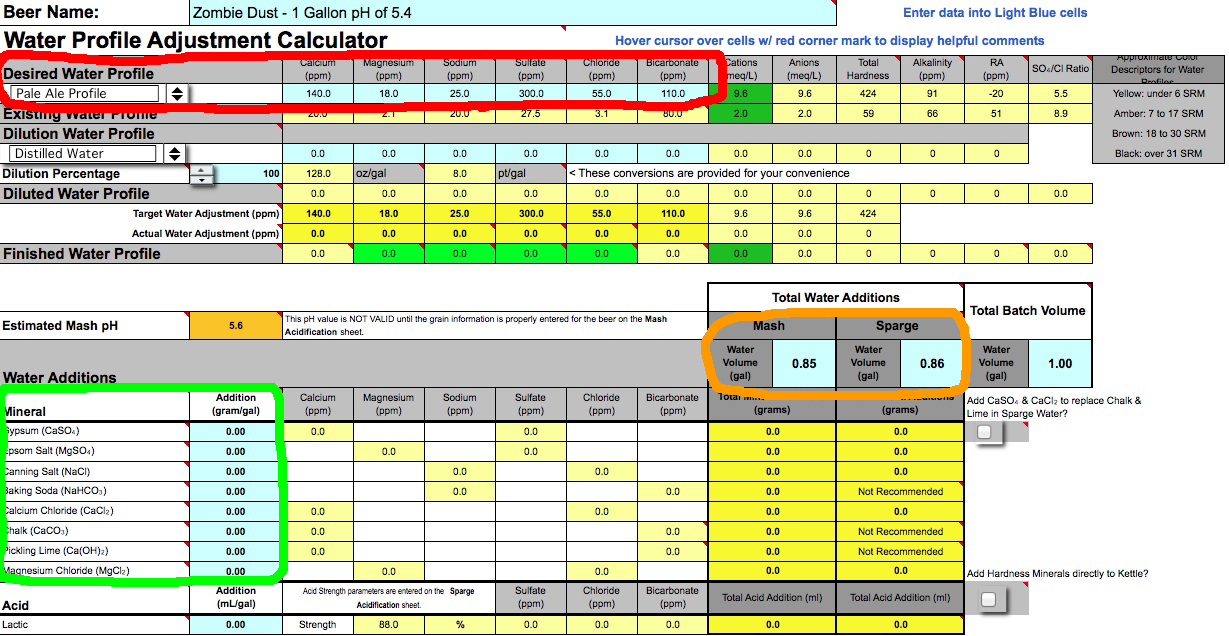

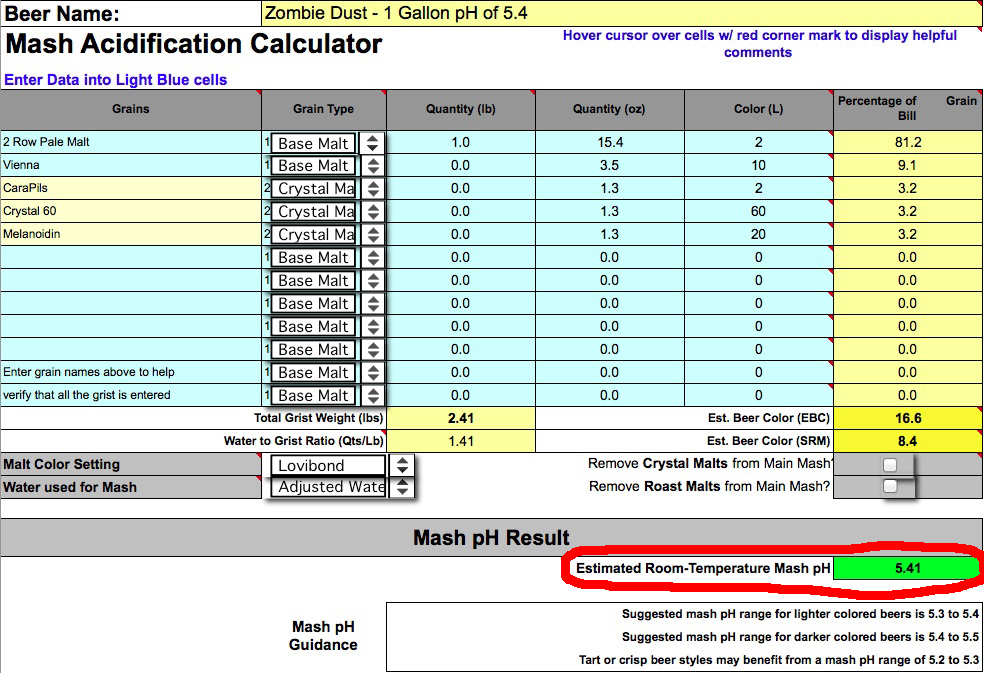
The first picture is a screenshot of the "Mash Acidification" tab. Hopefully, the grain bill will look familiar to you (but given that this was for a 1 gallon batch, your weights will be approximately 5.5x bigger) - see the area circled in red. Given the grain bill alone, you really can't know anything about the resulting mash pH. Without any salts added and using 100% distilled water (this will be obvious on my second screen shot), Bru'n Water estimates a mash pH of 5.56 - see the area in the lower right circled in green. Don't worry, we'll fix this in the next step.
With this tab properly filled out, the next tab you should attend to is the "Water Adjustment" tab - see the second picture. On this tab, you add your salts with two goals in mind - 1) hit your "Desired Water Profile" (see the upper left corner of the "Water Adjustment" tab where I have circled in red) and 2) hit your mash pH. You do this by adding the various salts that I have indicated in the green circled area. In the second screenshot, I have not yet added anything so you see a bunch of zeros in the green circled area and you see that the mash pH is off (as was seen on the previous screenshot). In this screenshot, I have already entered my mash and sparge volumes - see the area circled in orange. Also note that I have assumed that I am working with 100% distilled water - note the area below the red circled area and to the right hand side of the spreadsheet.
Now I start adding salts - see the third screenshot. Keep your eye on the two goals of Profile and pH. It's a trial and error process really. Simply make a change and see what happens (don't worry here - you can't screw up a beer by playing with a spreadsheet). Change a salt addition and watch what happens to your two targets. When you get close to your target water profile AND your target pH, you're done - see the third screenshot. I got pretty close to the desired water profile (the area circled in red) and my target pH (the area circled in green). The required additions for the mash and sparge additions are circled in orange.
I hope this is clear enough as to what I did - it is to me (but I'm just now finishing a ZD clone that is quite delicious). I highly recommend picking up the paid version of Bru'n Water (you decide how much it is worth to you - hint: it is worth more than you think). The screenshots that I have provided are from the paid version. I'm pretty sure that you get two decimal points on the estimated pH on the "Mash Acidification" tab. I like knowing that I'm not working at a mash pH somewhere between 5.35 and 5.44 when I'm shooting for 5.40; I like to see that I am pretty darn close. In this case, the final screenshot shows that I am at an estimated pH of 5.41 - see the fourth screenshot in the red circled area.
It is NOT as complex as it may first appear to be. Go through it once or twice just to exercise the spreadsheet, and you'll be fine. Another option is just to go with the water primer for your first couple of water adjustment attempts.
You know what? This ZD is pretty good! I think I'll have another!





OK. Here goes. I'm going to (try to) share some pictures from my version of Bru'n Water. I'll start off with a listing of the grist that I used for the version of Zombie Dust that I brewed.
Interesting post - good description of the process.
Working from this recipe, with a few minor changes, the Zombie Dust recipe in BeerSmith, with water adjustments in Brun Water:


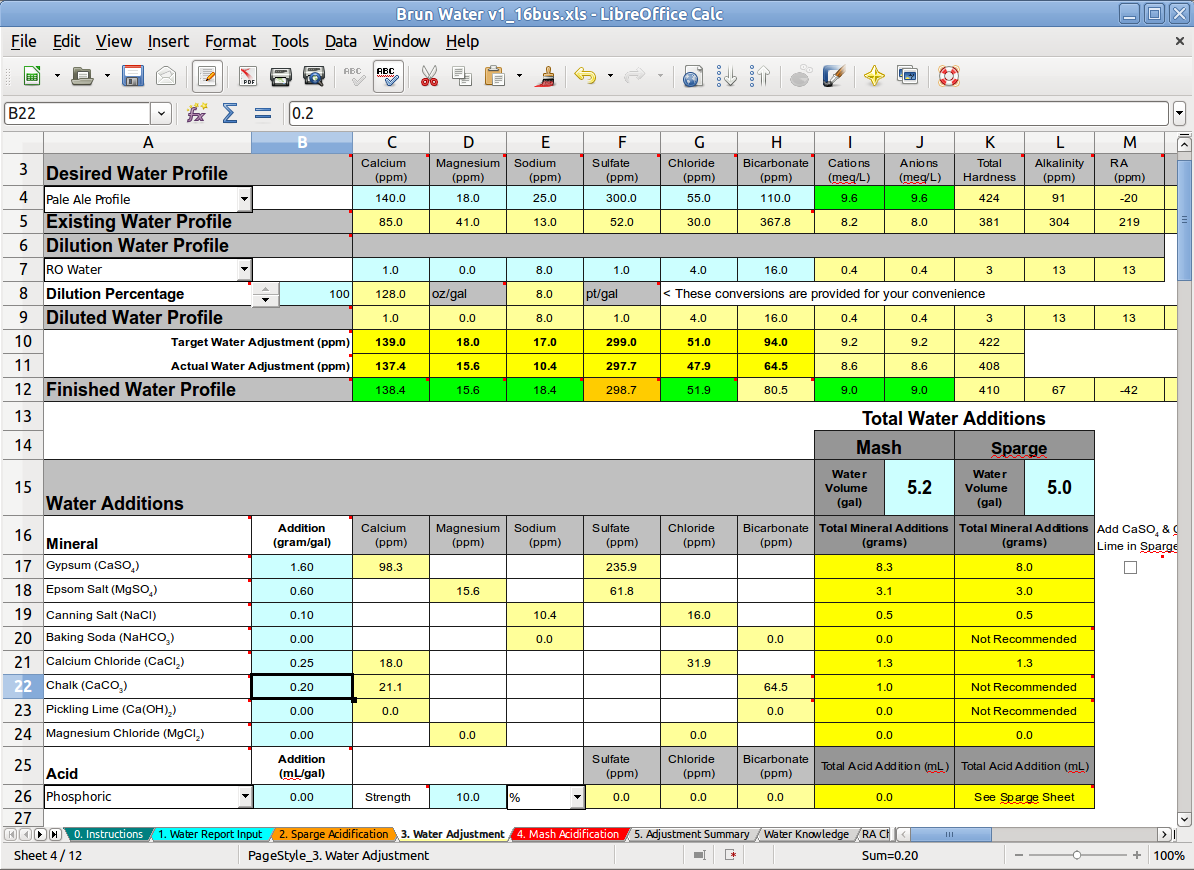
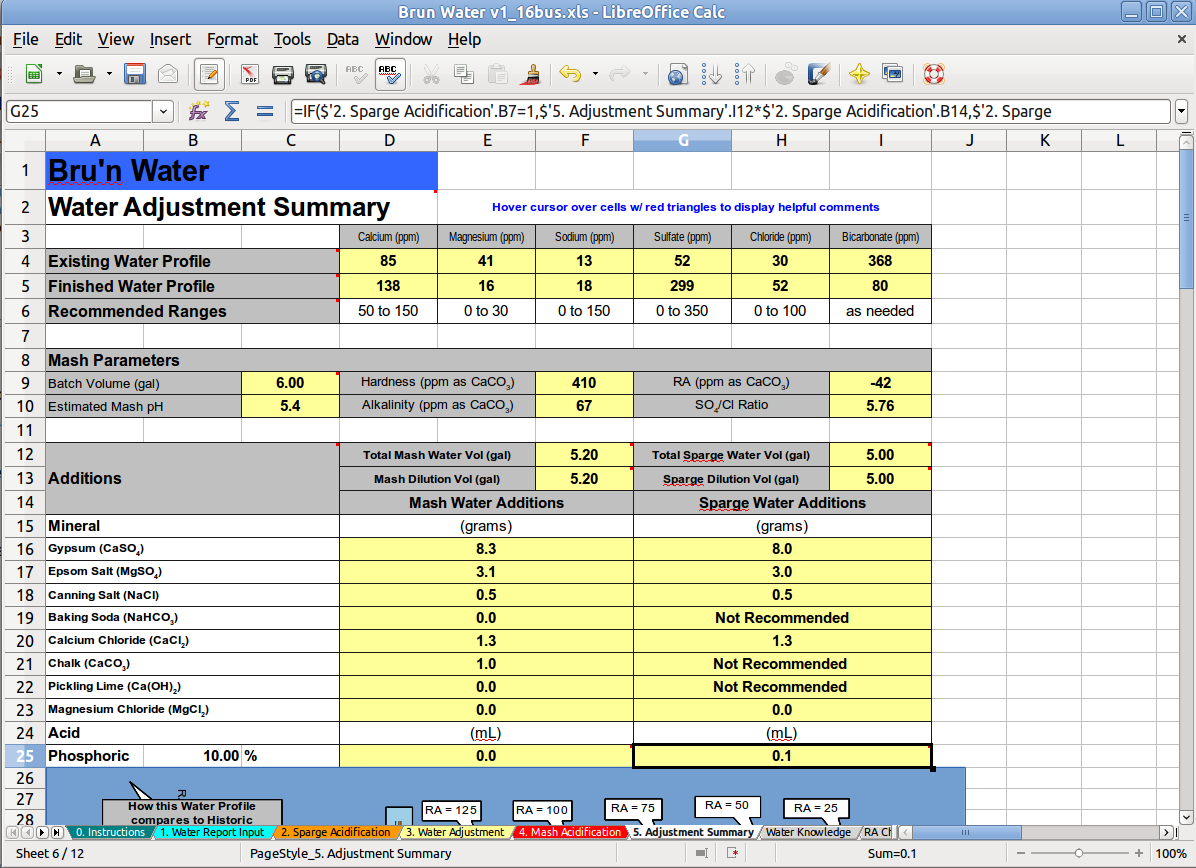




PlinyTheMiddleAged
Well-Known Member
- Joined
- Jan 9, 2014
- Messages
- 377
- Reaction score
- 106
MikeInMKE,
Looks good to me. The additions are bringing you in line with your targeted profile. And more importantly, your pH is right where it needs to be.
Good luck!
Looks good to me. The additions are bringing you in line with your targeted profile. And more importantly, your pH is right where it needs to be.
Good luck!
laxsoccerguy
Well-Known Member
I found that I prefer a mash pH of 5.4ish for my IPAs as well. At least, the ones I"ve done over and over. I think it really has "bright" flavors that way, for lack of a better term. Since I brew mostly APAs, IPAs, and American reds with a blonde or a lager tossed in the mix, that was a big "Aha!" moment for me.
Is this a Mash PH on the HOT side (mash temP) or cooled down to room temp?
laxsoccerguy
Well-Known Member
nvm, I see now. thanks!
Similar threads
- Replies
- 5
- Views
- 399
- Replies
- 3
- Views
- 251
- Replies
- 30
- Views
- 1K
- Replies
- 7
- Views
- 542

